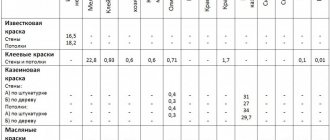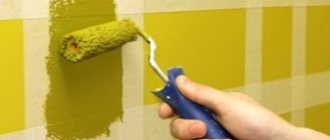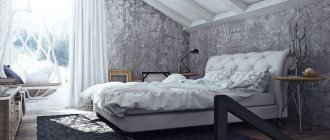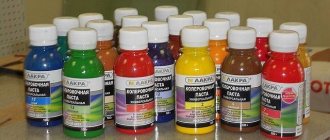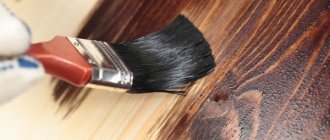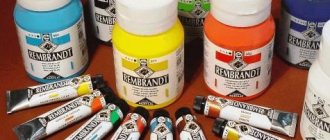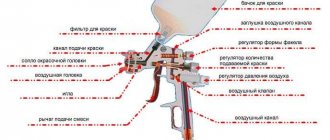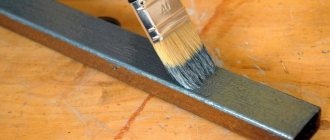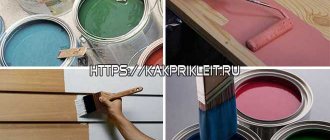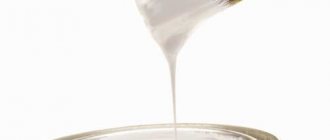At least once every five years a person faces a repair issue. Many people find themselves choosing which paint is best to purchase to update their interior. It is necessary to find out the difference between water-based paint and water-dispersion paint, analyze the technical characteristics of each type (composition, specific gravity, advantages, disadvantages, etc.), and make a decision taking into account its inherent features.
Properties
It is easier to determine the difference between water-dispersion and water-based paints once you know the criteria and product characteristics. They have both similar and different characteristics:
- main, auxiliary components;
- specific gravity of the coating, load;
- viscosity, solvents, temperature dependence;
- consumption of coloring solution per square meter of area;
- features of application, choice of method;
- shelf life during which the original indicators are retained.
Advantages and disadvantages
We looked at what dispersion paint is. Now let's highlight its advantages and disadvantages. The first thing worth noting is that the product is safe and environmentally friendly due to the use of water as a solvent. The paint does not have an unpleasant odor, it does not burn, and mold and mildew do not form on the painted surface - this means that the paint breathes.
The lifespan of the dye is about 15 years. In this case, the material will not swell or crack. It takes about two hours for the layer to dry completely. Also among the advantages is the affordable price.
There are also disadvantages - the quality of the treated surface depends on the weather. Do not paint during precipitation or low temperatures. During precipitation, the water will not evaporate. Painting at high temperatures is also not recommended. Before starting work, you need to prepare the surface - you need it to be level. A thin layer of paint will not be able to hide unevenness. Another disadvantage is that the price may be higher than those products that use other solvents.
Water-based paints
The basis of this variety is water, which dilutes all kinds of thickeners, pigments, and polymer compounds. The whitening component is zinc oxide, styrene acrylate forms a protective film. The purpose and characteristics of the product depend on the percentage of components. Viscosity is changed by the amount of solvent.
Improving the versatility of the finished product, manufacturers add resins:
- mineral;
- acrylic;
- silicone.
The specific gravity of the protective coating formed is 1.4-1.5 kg, the consumption of such products is 210 ml per 1 sq. meter. This indicator is variable, changing from the following data:
- type of surface to be painted;
- amount of added solvent;
- how much the base absorbs;
- other.
Advantages:
- environmental safety, no odor, no harmful fumes;
- ease of use, choice of any known method;
- color change is carried out by adding pigment;
- availability, low consumption.
There are several types, differing in composition, scope of application, characteristics, properties:
- silicate;
- acrylic;
- mineral;
- silicone.
The acrylic variety is universal; it paints glass, metal, brick, concrete, wood and surfaces made from them equally well. Silicone and mineral solutions are of good quality, but expensive; silicate types are used in rooms with high humidity.
Features of acrylic compositions
The main components of this group are acrylic composite and water. During the drying process, not only moisture evaporates, but also polymerization of the components occurs, resulting in the formation of a highly durable coating.
Acrylic is suitable for working with glass, metal, wood, canvas, linen and other materials that have a non-greasy base. Fresh stains of this type of paint can be easily washed off with plain water. However, if the stain has already dried, you have to resort to using a solvent.
Advantages of acrylic paints.
- The products are non-toxic and considered environmentally friendly. They are practically odorless and do not contain harmful substances.
- A wide color palette allows you to choose an option for every taste. In addition, you can prepare the shade you need in a special machine.
- Acrylic paints are resistant to ultraviolet radiation, high humidity and temperature changes. They can be used for finishing both indoors and outdoors. Also, this group of paints and varnishes has a vapor-permeable coating layer, which eliminates the accumulation of moisture in the walls.
- Acrylic coating is durable (it remains in excellent condition twice as long as oil coating).
- The layers dry very quickly. There are brands whose compositions dry in 1 hour.
- The quality and aesthetics of the appearance of the painted surface will satisfy the most demanding customers. After drying, the layers do not crack.
- The paints are frost-resistant (freeze at temperatures below – 40°). However, it should be remembered that thawing should be gradual, even if it takes several days. This process cannot be accelerated with the help of heating devices, hot water, etc. After the paint has thawed, it is necessary to check whether thickened particles have appeared in it or whether it has delaminated. Then you should thoroughly stir the composition and dilute it with water, if necessary.
Water-dispersed
An aqueous dispersion that dissolves acrylic, polyvinyl acetate and latex components. You can find out what water-dispersion paint is by determining its characteristics. The components dissolved in PVA form a mixture that is inexpensive and wear-resistant. It is used for painting floor coverings, but quickly gets dirty and allows moisture to pass through.
Based on latex, it is stronger than water-based, more stable, has dirt- and water-repellent properties, and the acrylic solution of components is used for exterior decoration of buildings and is well resistant to atmospheric phenomena. The protective surface perfectly withstands repeated cleaning, washing, and treatment with products.
Conclusion
Despite the fact that most of the composition of the presented paints is made up of ordinary water, they can differ significantly in cost. In addition, materials differ in their hiding power.
It should also be said that dispersed paints are resistant to water, while emulsion paints are easy to wash off from the surface. The materials also differ in the solvent used. To control the density of dispersed compositions, water is used, and emulsion compositions use white spirit. In addition, the first option is produced exclusively in white, while the second can be multi-colored or tinted.
Advantages of water-based solutions
It is recommended to paint surfaces at temperatures above 5 degrees. The protective layer dries quickly enough; re-application of the mixture can begin after 2 hours. They do not require careful surface preparation - they fill small gaps and cracks well.
Advantages inherent in the varieties:
- form a breathable surface;
- durable, retain their original properties for a long time;
- resistance to temperature changes;
- aggressive cleaning agents do not cause harm;
- absence of harmful components, odor;
- compatible with any surfaces except metal.
Application
Is it difficult to paint walls or ceilings yourself? Let's find out.
The video in this article will help you learn more about how to perfectly paint a ceiling.
Surface preparation
It consists of three stages:
Painting
What tools can be used for painting?
Quite standard: brushes, rollers and spray guns. The author uses a wide roller with medium pile and a medium-width brush to paint corners and other areas that are problematic for the roller. A paint tray is useful for rolling out the roller, and masking tape is used to protect surfaces not intended for painting.
For painting surfaces in residential premises, water-dispersed or water-based paints are most often used. Despite the fact that the base substance in both cases is water, these compositions are still different.
Below we will discuss the main differences between water-dispersion and water-based paints. To understand what they are, it is necessary to take into account the technical indicators: composition, consumption, viscosity, hiding power, specific gravity, durability, as well as the operating characteristics of the materials.
This type of coatings is widely known to domestic users and has found application in many areas due to the following advantages:
Disadvantages include exposure to low temperatures, especially at the time of application. The operating temperature should be above 5 degrees. In addition, this type of material should not be applied to metal products or surfaces that absorb a lot of moisture. In the first case, the paint will cause corrosion, in the second - premature destruction of the surface.
Water-based paints are intended exclusively for interior or facade work
Specifications
Water-based coatings include ingredients such as latex, thickeners, fillers and optional additives to increase resistance to water, ultraviolet rays, and so on. The viscosity of this material is controlled by water. To determine this indicator, a special tool is used - a viscometer. The optimal viscosity is 40-45 St when using hand tools (rollers, brushes, sponges, etc.). If you plan to apply the material using a spray gun, then this indicator should be no more than 25 Art.
If we take the average data provided by manufacturers, then the consumption of water-based paint is 200 ml per 1 square meter of treated surface. But in reality, this characteristic may be different due to the absorbency of the base, the degree of its preparation, the tool used, and so on.
The average specific gravity of this type of paint does not exceed 1.4 kilograms per liter. The drying time directly depends on the humidity and temperature in the room. Also, different compositions can dry for different times: from 2 hours to a day. It should also be noted that painting work is best carried out at a temperature of about 20 degrees Celsius and a relative air humidity of 65-70%.
Types of water-based compositions
The modern construction market offers the following types of materials:
Difference
The difference between water-based and water-dispersion paint is invisible to the naked eye. The first variety covers surfaces better due to its good viscosity, and consumes less because it is not absorbed. The second mixture is stronger, wear-resistant, and durable.
The increased moisture resistance of dispersion products significantly expands the scope of use, while emulsion products are easily washed off with water, which makes them unsuitable for exterior decoration, treatment of bathrooms, baths, saunas.
Water-based paints also differ from water-dispersion paints in their use of solvents. The first type of mixture is recommended to be diluted with weak, medium-strength solvents; for the second type, ordinary water is sufficient. Although they have similar names, they still differ from each other.
The mixtures have many similar characteristics, but differ in properties, prices, and solvents. They are not interchangeable solutions; they are used in different areas, which are dictated by increased or decreased moisture resistance. When choosing the right solution, they rely on the type of base being treated.
What to look for when choosing
When choosing paint for the ceiling, it is recommended to adhere to the following criteria:
- When choosing the color and texture of the material for painting the ceiling, you need to take the interior style of the room, its purpose and the dominant color shades as a guide. Ceiling paint can be matte, semi-gloss or glossy. The latter option helps to achieve a visual expansion of space. Matte white paint imparts a discreet nobility and balance to the home.
- Preparing the base for painting is labor-intensive, because... the finished surface must be perfectly flat. It will require laying several layers of putty and sanding. It is impossible to disguise even small defects with painting: as a rule, they become even more noticeable. First of all, this applies to glossy compositions that highlight all the depressions or bulges well. Matte paint is more practical in this regard, as it allows you to hide minor flaws. The best option in such situations are semi-gloss materials.
- Water-based paint contains water, so it does not tolerate freezing very well. Based on this, it is not recommended to purchase material in winter from unheated markets and warehouses. In essence, these are paints for ceilings in residential premises.
- It may seem that both expensive and cheap paints have similar characteristics. Expensive brands have superiority in practicality: this means material consumption per m2 of base. This is especially noticeable when painting large spaces.
- It is worth understanding that the popularity of a brand does not always indicate its quality. Sometimes lesser-known materials have better performance characteristics. The point is in fakes, which often use popular logos. In addition, new manufacturers are trying to win their place in the sun due to the high quality of their products and their low cost.
- In most cases, paint buckets contain instructions that the material is intended for finishing ceilings. If there are no indications of narrow specialization, then universal paints for interior work are a suitable option. As a rule, these compositions adhere very well to the base, which allows you to get rid of drops on the surface.
- Sometimes during painting, instead of the declared snow-white surface, a slight tint appears on the ceiling. Good manufacturers specifically introduce a special pigment into the composition, which helps to quickly notice unpainted areas. As a rule, after drying the surface becomes completely uniform and white.
- Using glossy paint, a mirror effect is created on the ceiling. Perfectly smooth surfaces painted in this way look especially beautiful. Glossy compositions are recommended for use in small rooms to achieve a visual expansion of space. After drying, such a ceiling can be wiped with a damp cloth.
- Due to the fact that matte paint absorbs light, it can be used to mask small defects in the base. The layer turns out to be dense, which in some cases makes it possible to save on the number of approaches. After drying, matte paint becomes covered with small pores, making it difficult to clean.
Table
| Water-based paint | Waterborne paint |
| Good hiding power | Average hiding power |
| Price varies, but on average more expensive | Cheaper (not much) |
| Available in various color options | Only white color. Requires additional movements to add color |
| Diluted with organic solvents (white spirit and analogues) | Water-based paint is diluted with water |
| Drying time: several hours (2-6 hours) | Drying speed - from 30 minutes. up to 2 hours |
So, we hope that our article has given you a clear idea of the difference between water-based paint and water-based paint. This means that when you visit a construction supermarket, you won’t have to be embarrassed asking the ever-busy consultants about the advantages and disadvantages of these paints and varnishes. Now you are quite savvy in this matter and can advise anyone yourself.
Varieties
Acrylic paints are universal because they are available in several versions, each of which has its own purpose:
- Washable. Withstands from 1500 to 3000 wet cleaning cycles. Contains latex to resist moisture. Great for use in kitchens, bathrooms and kitchens.
- Atmospheric. Designed specifically for exterior painting work, they are characterized by increased resistance to external negative weather phenomena, including precipitation, high and low temperatures.
- Internal. Designed for interior decoration. They are characterized by high service life and abrasion resistance.
- Facade. Used for painting building facades. They are an excellent alternative to more expensive siding.
The choice of variety is directly determined by what surfaces are planned to be painted. This ensures the durability and reliability of the painted surface.
How to choose
When choosing, it is important to consider the differences described above. They start by assessing the type of room in which the work is planned to be carried out. Not just any paint is suitable for cold rooms. You should also take into account the specific conditions in the room, including humidity levels, etc.
Among other things, when choosing a composition, you should focus on the following nuances:
- Price. If you do not plan to spend a large amount on facing material, then the water-dispersion type. They are cheaper;
- Manufacturer. This affects the quality of the material. It is recommended to choose brands that have proven themselves on the positive side. This will allow you to purchase a high-quality composition that is reliable and durable;
- Room design. Depending on the interior, a suitable palette will be selected. Not all types of paints have a rich range of shades. Therefore, the desired composition may not be in the desired tone.
Depending on the interior, a suitable palette will be selected.
The water base of both types is their common feature. But there are enough differences. They affect further operation. Therefore, it is necessary to familiarize yourself with the nuances of each composition in advance in order to choose the most suitable one.
Differences
Despite the similarity of names, the difference between water-based and water-dispersion coatings is obvious:
- Dispersion assumes the presence of tiny particles in the base. If such particles take the form of a liquid, then we are talking about an emulsion.
- The water-dispersion coating is harder and highly resistant to damage, which cannot be said about water-based paint. The cost of water-based paints is often higher.
- Water-dispersion paint is reliable and water-resistant, while water-based paint is easy to wash off.
- Water-based paint has a wide range of different shades; water-dispersion coating comes in only one color - white.
- Water-dispersed materials must be diluted with water, emulsion materials need to be diluted with organic solvents.
Knowing the distinctive properties and advantages that both types of paints have will guarantee the correct choice of paint coating.
An important rule that should be followed when choosing and purchasing coverage is that you should give preference only to trusted manufacturers and specialized stores with a good reputation.
There are other tips for choosing paint, which you can learn from the following video.
